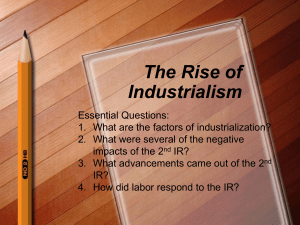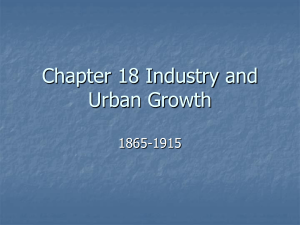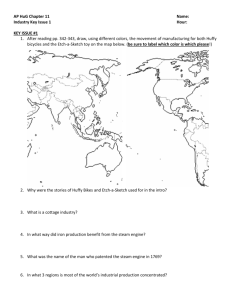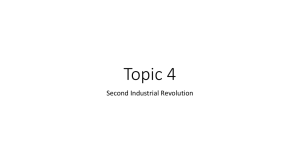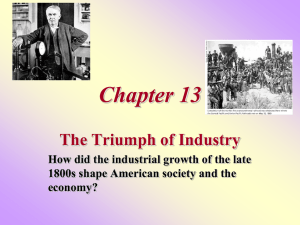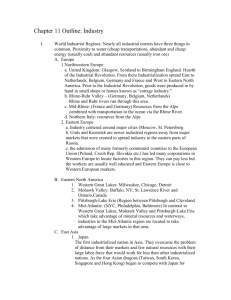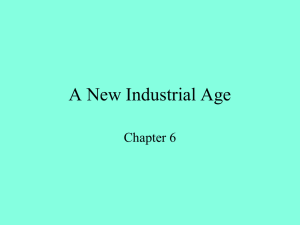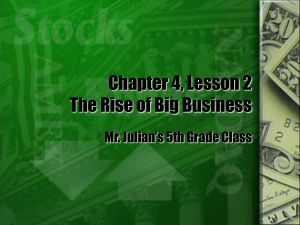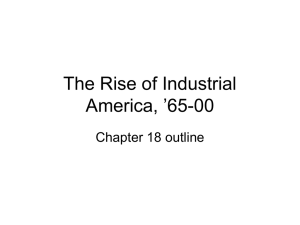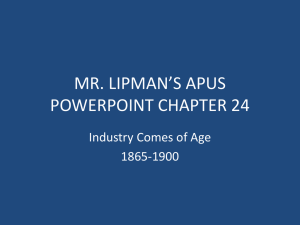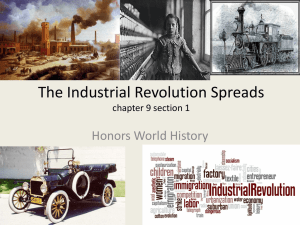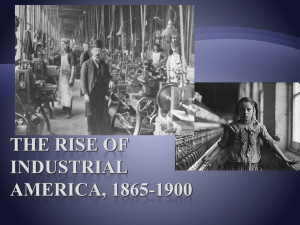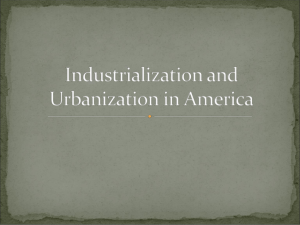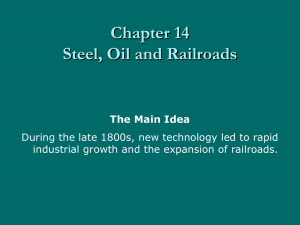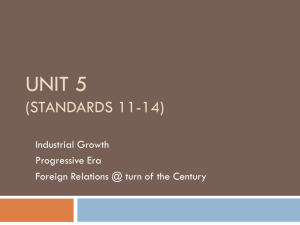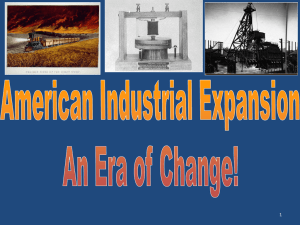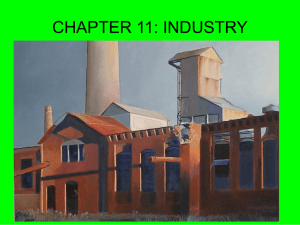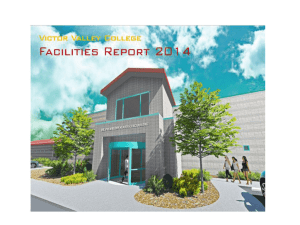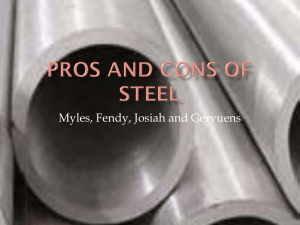The Rise of Industrialism
advertisement
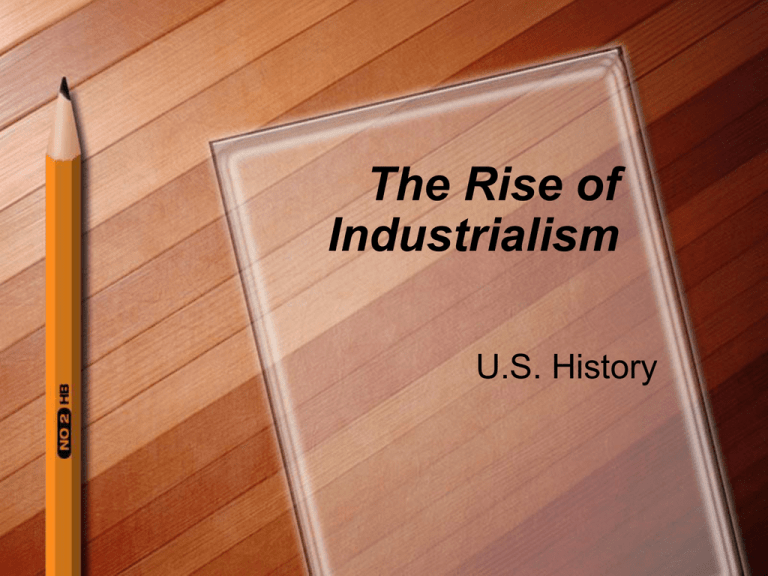
The Rise of Industrialism U.S. History The Rise of Industrialism A change from hand craftsmanship to machine manufacturing. By 1900, the U.S. produced more industrial goods than any other country in the world. Factors in Industrial Growth The following are reasons the U.S. was able to industrialize: 1) Abundant supply of natural resources – Oil, coal, timber, iron – All used to build goods, and power factories Factors in Industrial Growth 2) Improved transportation methods (the railroad) – Businesses could transport goods from coast to coast. – Farms on the west coast could buy tractors from the east coast. Factors in Industrial Growth 3) Population shift: more people lived in urban areas instead of rural areas. – most took jobs in factories. – The population shift supplied factories with a large labor supply. Factors in Industrial Growth 4) Government supported industrial growth by: – Subsidized railroad construction – Maintained a laissez-faire approach – Few taxes – No env. controls Talk to your neighbor: What were the factors of Industrial growth in the U.S.? Spirit of Innovation Between 18601900 676,000 patents granted Universities became magnets Steel The “Bessemer Process” made producing steel faster and cost effective. The skyscraper appeared. Bridges held greater loads. Steel railroads could carry steel railcars with heavy goods faster than iron railroads. Electricity Becomes Widespread Businesses installed electrical elevators (made with steel) – Allowed buildings to be built with multiple floors Factories installed lighting – Allowed factory to operate 24/7 Stores installed lighting and heating – Allowed stores to stay open later, and in cold weather The Telegraph • Speech is transmitted across electrical wires Electricity Becomes Widespread Elias Howe’s sewing machine allowed increased production in the textile industry Textile industry used the machines to create mass quantities of “ready to wear” clothing.“ Talk to your neighbor: 1) Why was steel considered the #1 innovation? 2) How did electricity become widespread in the 19th C? Industrial Leaders John D. Rockefeller – Formed the company Standard Oil – Controlled 90% of the country’s oil – Owned the oil refineries, the pipelines and railroads Industrial Leaders Andrew Carnegie – Built a steel company – By 1900 his company supplied 1/4 of all steel on the market. – Used his capitol (money) to ensure he had the lowest price, and therefore no one else could compete Extravagant Wealth of Industrial Leaders Vanderbilt’s NYC home Vanderbilt’s NC home Amassed fortunes Multiple homes worth millions of dollars Outrageous parties The Gilded Age • Term coined by Mark Twain • Gilded = covered thinly w/ gold leaf or paint • Analogy used for American society • Golden on the outside and rotting on the inside The Rise of Trusts • Competing businesses combined to create monstrous firms called trusts. • Examples: • 5,300 independent manufacturers 319 Industrial trusts • 2,400 utilities companies (RR, electricity, water) 127 utility trusts • Same happens in oil, coal, steel, whiskey, sugar, tobacco, banking, farm machinery Trusts Influence Gov’t Affairs • Industrial giants ran for office. • Manipulated gov’t by: • giving lots of $ to political candidates. • bribing lawmakers to de-regulate business, take an anti-union stance, impose high tariffs (taxes) on foreign goods. • What do you see? • Who are the men with hats? • Who are the men at the desks? • What is the message of the cartoon? Wealthy Americans Face Criticism Wide gap between rich and poor. Material wealth of 1% of population greater than that of other 99% combined. Few individuals control majority of America’s natural resources, industries and utilities. Industrialists Defend Big Business • Industrialist argued that they deserved their wealth because they took the most risk. • In 1889, Carnegie wrote The Gospel of Wealth, arguing the rich deserved what they had, but they should share it. Impacts of Industrialism: The Middle Class Rise of the Middle Class – Families who could earn a comfortable living and afford extra consumer goods on top of necessities. Able to buy property and send children to college Jobs included managers, technical workers, sales people, industrial skilled workers Impacts of Industrialism: The Average American Lived in crowded city tenements or employer owned company towns. Most still used candles to light homes, no indoor plumbing or heating. Could not afford the consumer goods THEY were producing in factories. Industrial Working Conditions “Become a hand – not a brain, not a soul – deadened into a part of a machine” • Most worked in steel mills, coal mines, garment factories, shipyards or on railroad tracks • 10-12 hours six days a week • Crowded, uncomfortable, dangerous factories • Monotonous work What do you see? -Where is this picture taken? -Describe the people in the picture -How old are they? -What is it like to work in these conditions? -What problems do they face? Discrimination in the Work Force Women: • entered the public work force. • Paid half of what men were paid. Child Labor: • 1.75 million children ages 6 15 worked in mines and factories in the late 1800s. • Most dangerous jobs. • Young bodies suffered from • deformities, asthma, stunted growth. Minority Laborers: • New immigrants and African Americans did the most tedious jobs for the lowest pay. • African-Am competed against other immigrants and accepted lowest wages and toughest schedules. • Business managers pitted ethnic groups against each other. Job/Ethnicity : Pay: Cigar Rollers/ 92% Chinese $287 per year Tailors/ 91% White $588 per year Talk to your neighbor: Industrialization had many positive and negative impacts on American society. How did industrialization negatively impact Americans? Labor Unions Emerge • • • • Work collectively to be able to bargain w/ big business. 1897: 440,000 union workers 1904: 2M union workers Knights of Labor • Accepted women and Af-Am • Wanted an 8 hr work day, income tax, elimination of child labor, equal pay for men and women • American Federation of Labor (AFL) was a union for white, male, skilled workers. • Socialist Union groups: Wobblies. Business Response to Labor • Industrialists fought against unions. • Often accused union leaders of being communists or terrorists. • Gov’t supported big business -with anti-union legislation. -breaking up strikes. Strikes and Violence • Workers often went on strike, which means they refused to work until their demands were met. • Many times, federal troops were called in to restore order and things turned violent. • Great Railroad Strike • Haymarket Affair Union Victories • Eventually most business were forced to: -shorten work hours -compensate for injuries -stop hiring young children -provide breaks -improve health standards in work places Talk to your neighbor: What demands did labor unions make of big business? Why should Americans appreciate the work of labor unions in the late 19th and early 20th centuries?
